Useful tips for beginners regarding knitting berets with knitting needles and crochet.
Contents
- How to tie the bottom and elastic band with berets?
- How to tie a rubber band with berets?
- How to tie the bottom of beret with knitting needles?
- Knitting beret with knitting needles for beginners: detailed description
- Knitting beret with knitting needles
- Knitting beret with knitting needles
- Simple female takes knitting needles with description for beginners
- Baby takes knives for beginners
- Berets with pompon
- Warm beret with braids
- Berets with tracery patternfor the smallest
- Patterns for berets with knitting needles: charts and description
- The size of the bottom beret crochet: how not to be mistaken in size?
- Video: Hook for beginners - knitting circle
- Crochet elastic band: description
- Video: RUBBER HOOK.Knitting Patterns
- Crochet Crochet Crochet for Beginners: detailed description
- Video: Beret Classic Crochet
- Summer Crochet: Diagram and Description for Beginners
- Baby Berets for Beginners
- Video: How to knit a children's summer crochet. How to crochet beret free pattern tutorial #crochet_beret
- Crochet pattern for a beret: sketch and description
- How to tie a crochet for beginners: video
- Video: Summer crochet for beginners 1 part Crochet
- Video: Summer crochet for beginners Part 2crochet beret?
How to tie the bottom and gum with berries?
Beret, like any other headgear, can be tied in two ways:
- from a rubber band
- from the bottom( crown, pancake).
How to tie a rubber band with berets?
- Measure the head circumference( OG).
- Tie the sample( 20 loops x 20 rows) and determine the density of knitting( PV).
- Determine the number of loops for the beret gum:( OG-4 cm) * MF, where 4 cm is the standard reduction for the knitted fabric.
How to tie the bottom of a beret with knitting needles?
- Measure the head circumference( OG).
- Determine the diameter of the bottom: OG / 2.
- Type 6( 8) hinges on the spokes.
- 1-st series tie alternately: 1 face loop, cape.
- The resulting number of loops are divided into 6( 8) wedges.
- Continue working by adding loops in each 2nd row at the beginning and at the end of each wedge. Make sure that the bottom of the beret remains flat. If necessary, make an increase less often( for example, in every 4th row).
Knitting beret with knitting needles for beginners: detailed description of
Do you know how to knit the facial loops and make the capes? Then you can connect the fashionable hat to your strength.
Knitting beret with knitting needles
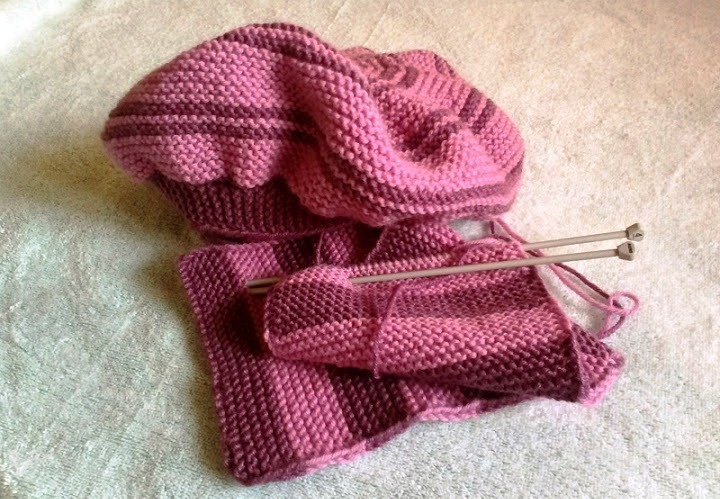 Berets for beginners
Berets for beginners Berth size( = head girth): 56.
For work you will need :
- Yarn roving. Composition: 100% wool. Weight - 100 grams, the yardage - 100 m. For work you will need a thread in one addition. Remarkable in this product will look melange yarn.
- Spindles straight or circular # 2,5
- Circular knitting needles # 5
Abbreviations used in description:
KP - edge loop
PI - reverse loop
LP - face loop
LSP - front crossed loop( see photo below)
MP - marked loop
2PVLP - 2 hinges together front with a slope to the right
2 PVLL - 2 hinges together facing with a slope to the left
H - nakid
PW - swivel series
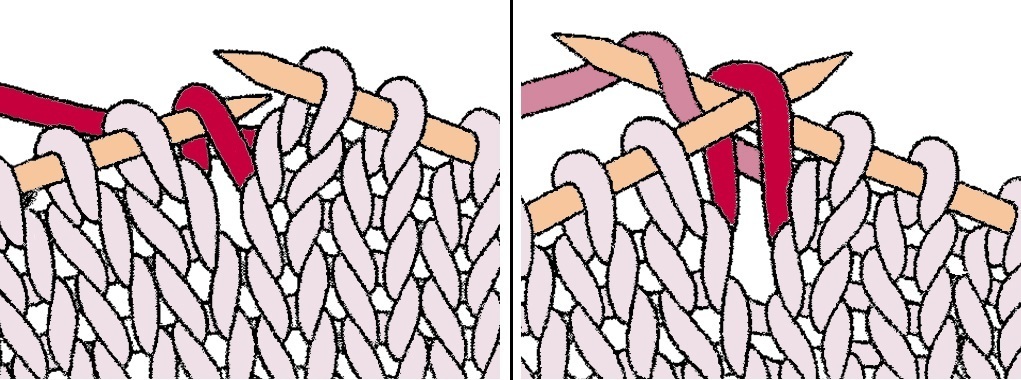 Nakid tied with a front crossed loop
Nakid tied with a front crossed loop 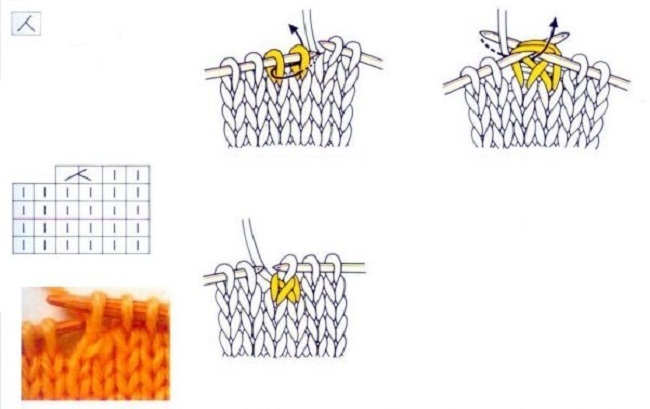 Two hinges together facing with a slope right
Two hinges together facing with a slope right 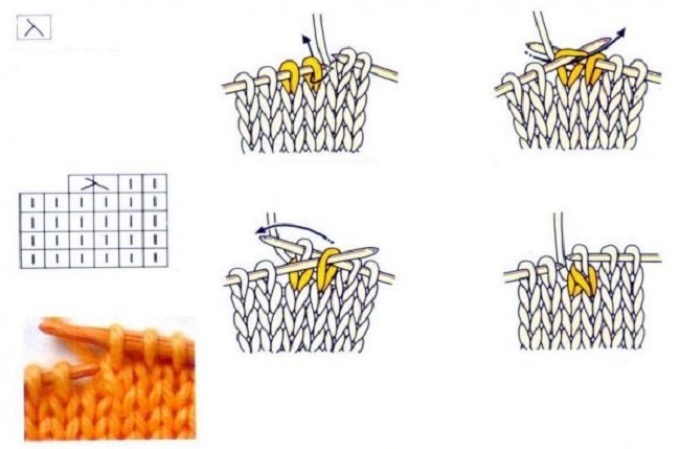 Two hinges face together with a slope to the left
Two hinges face together with a slope to the left Main pattern of the : garter stitch. All PRs are knit LPs.
Finishing : rubber band 2x2( 1x1).
Job description:
- Type 7 loops on spokes # 5.
- Tie the bottom( pancake) of the beret:
1st OL: KP, * N, LP.We repeat from * to the end of the PR.The last CP.After adding on the spoke - 13 loops.
2nd and all even PR: LP, H is fastened with LSP.
3rd PR: knit as 1st PR.After adding on the spoke - 25 loops.
Tip: At this point, in order to avoid mistakes and to form accurate even wedges, mark every 4th loop in any convenient way( for example, a colored thread or an English pin).After marking on your spoke: CP, 1 loop, MP, 3 loops, MP, 3 loops, MP, 3 loops, MP, 3 loops, MP, 3 loops, MP, 1 loop, CP.Labeled loops( MP) - 6. In the following, the marked loops are knitted with the basic pattern.
Important: During operation, make sure that the bottom is flat.
5 th PR: KP, 1 LP, N, MP, N, 3 LP, N, MP, N, 3 L, N, MP, N, 3 L, N, MP, N, 3 L, N, MP, H, 3 L, H, MP, H, 1 LP, KP.After adding to the spoke - 37 loops.
7th PR: KP, 2 LP, N, MP, N, 5 LP, N, MP, N, 5 LP, N, MP, N, 5 LP, N, MP, N, 5 LP, N, MP, Н, 5 ЛП, Н, МП, Н, 2 LP, КП.After adding on the spoke - 49 loops.
9th PR: KP, 3 LP, N, MP, N, 7 LP, N, MP, N, 7 LP, N, MP, N, 7 LP, N, MP, H, 7 LP, N, MP, H, 7 LP, H, MP, H, 3 LP, KP.After adding to the spoke - 61 loop.
11th OL: is knitted without additions.
13th PR: KP, 4 LP, N, MP, N, 9 LP, N, MP, N, 9 LP, N, MP, N, 9 LP, N, MP, N, 9 LP, N, MP, Н, 9 ЛП, Н, МП, Н, 4 LP, КП.After adding on the spoke - 73 loops.
15th OL: is knitted without additions.
17th PR: KP, 5 LP, N, MP, H, 11 LP, N, MP, N, 11 LP, N, MP, H, 11 LP, N, MP, H, 11 LP, N, MP, H, 11 LP, H, MP, H, 5 LP, KP.After adding on the spoke - 85 loops.
19-th OL: it is knitted without additions.
21st PR: CP, 6 LP, N, MP, N, 13 LP, N, MP, N, 13 LP, N, MP, N, 13 LP, N, MP, N, 13 LP, N, MP, H, 13 LP, H, MP, H, 6 LP, KP.After adding to the spoke, there are 97 loops.
23rd OL: fit without additions.
25th PR: KP, 7 LP, N, MP, N, 15 LP, N, MP, N, 15 LP, N, MP, N, 15 LP, N, MP, N, 15 LP, N, MP, H, 15 LP, H, MP, H, 7 LP, KP.After adding on the spoke - 109 loops.
27th OL: is knitted without additions.
29th PR: CP, 8 LP, N, MP, N, 17 LP, N, MP, N, 17 LP, N, MP, N, 17 LP, N, MP, H, 17 LP, N, MP, H, 17 LP, H, MP, H, 8 LP, KP.After adding on the spokes - 121 loops.
31st OL: fit without additions.
29th PR: CP, 9 LP, N, MP, N, 19 LP, N, MP, N, 19 LP, N, MP, N, 19 LP, N, MP, N, 19 LP, N, MP, Н, 19 ЛП, Н, МП, Н, 9 ЛП, КП.After adding on the spoke - 133 loops.
30th OL: all facial.
The height of one wedge is 14 cm( from the beginning of knitting to the 30th PR).The width of one wedge( 22 loops) is 15 cm. Once you have reached these values - the bottom of the headdress is ready.
- Spray without additives 2-3 cm( 4-6 rows).If you want a more magnificent beret, increase the number of rows, tied without adding, to 8-10( 4-5 cm).
- To start the bottom of the beret, start loosening the loops:
35th PR: CP, 8 PL, 2 PVL, MP, 2 PVLP, 17 LP, 2 PVL, MP, 2 PVLP, 17 LP, 2 PVLL, MP, 2 PVPP, 17 LP, 2 PVLL, MP, 2 PVLP, 17 LP, 2 PVLL, MP, 2 PVLP, 17 LP, 2 PVLL, MP, 2 PVLP, 8 LP, KP.After reduction on the spoke - 121 loops.
of the 36th PR and all subsequent even numbers are knit LPs.
37th OL: is knitted without any reduction.
39th PR: CP, 7 PL, 2 PVLL, MP, 2 PVLP, 15 LP, 2 PVLL, MP, 2 PVLP, 15 LP, 2 PVLL, MP, 2 PVLP, 15 LP, 2 PVLL, MP, 2PVLP, 15 LP, 2 PVLL, MP, 2 PVLP, 15 LP, 2 PVLL, MP, 2 PVLP, 7 LP, KP.After reduction on the spoke, 109 loops.
41st OL: is knitted without any reduction.
43rd PR: KP, 6 PL, 2 PVLL, MP, 2 PVLP, 13 LP, 2 PVLL, MP, 2 PVLP, 13 LP, 2 PVLL, MP, 2 PVLP, 13 LP, 2 PVLL, MP, 2PVLP, 13 LP, 2 PVLL, MP, 2 PVLP, 13 LP, 2 PVLL, MP, 2 PVLP, 6 LP, KP.After the reduction on the spoke, there are 97 loops.
45th OL: is knitted without any reduction.
47-1 PR: CP, 5 PL, 2 PVLL, MP, 2 PVLP, 11 LP, 2 PVLL, MP, 2 PVLP, 11 LP, 2 PVLL, MP, 2 PVLP, 11 LP, 2 PVLL, MP, 2PVLP, 11 LP, 2 PVLL, MP, 2 PVLP, 11 LP, 2 PVLL, MP, 2 PVLP, 1 LP, KP.After reduction on the spoke - 85 loops.
The 48th OL plait the LP.
- Proceed to the decoration of the rim of the beret. To do this, go to the spokes # 2,5 and knit with an elastic band 2x2( 1x1) 4 cm. Close the hinges.
- The product is sewn on the wrong side.
Knitting beret with knitting needles
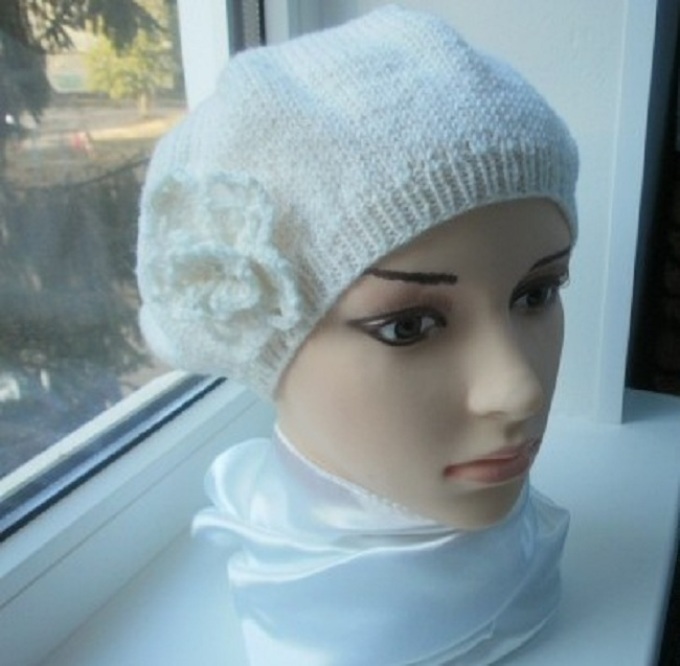 Knitting beret with knitting needles
Knitting beret with knitting needles Berth size( = head girth): 56.
For work you will need :
- Yarn, composition: 50% wool, 50% acrylic. Weight - 60 g. For work you will need a thread in one addition. Remarkable in this product will look melange yarn.
- Tongs straight or circular # 2,5
- Circular knitting needles # 4,5
- Crochet hook # 2,5
Abbreviations used in description:
Pocket - Edge Hinge
PI - Back Loop
LP - Face Hole
LSP - Frontcrossed hinge( see photo above)
MP - marked loop
2 PCL - 2 hinges together front with a slope to the left
H - nakid
KR - circular series
Basic pattern : facial smoothness. All KRs are knit LPs.
Finishing : elastic band 2x2( 1x1).
Job description:
- Dial 128 loops on the spokes # 2,5 close the set in a circle.
 Tips for getting started on circular knitting needles.
Tips for getting started on circular knitting needles. Important: Be sure to check the location of the tying loops before tying the first row. The loops must be inside the conditional circle. If necessary, eliminate the torsion of the row.
- Use an elastic band of 2x2( or 1x1) frontal hoop. The height of the part is 2 cm( 8 rows).Knitting beret knitting: work on the elastic band.
- Once the elastic has reached the required height, go to the face and evenly add 24 loops. To do this, make a crochet every 5 LP.After adding on knitting needles - 152 loops. In the next CD, wraps are tying LSP.
- Continue to knit LPs all subsequent CDs until the knitting height reaches 10 cm from the beginning of the set edge. So you will form the high-altitude part of the beret( tulle).Knitting beret knitting: work on the high-rise part.
- As soon as the altitude reaches the required value, proceed to the formation of the crown( bottom) of the beret. To do this, mark each 19th loop of the CD with a colored thread. You should get 8 identical parts, which will become future beret wedges. Knit alternately: 17 LP, 2 PVLL and so on until the end of the CD.Next CD after thinning knit LP.
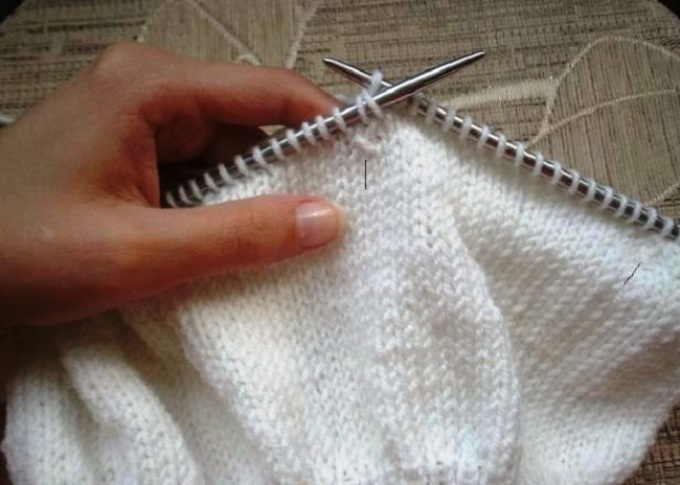 Knitting beret knitting: work on the top of the beret.
Knitting beret knitting: work on the top of the beret. - Continue to decrease the loops, focusing on the MP and gradually reducing the wedges of the beret
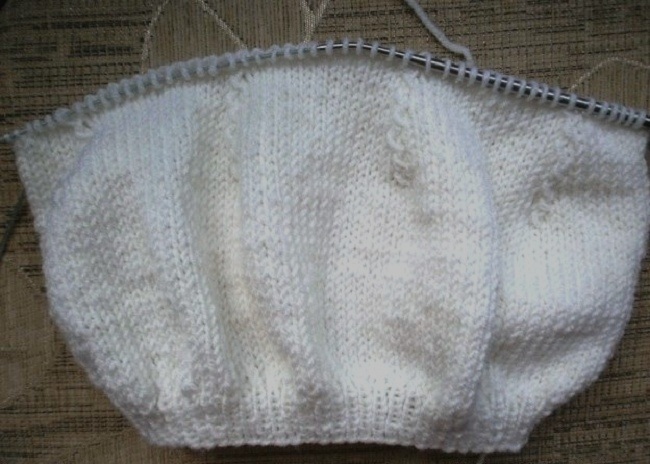 Knitting beret with knitting needles: work on the crown of the beret.
Knitting beret with knitting needles: work on the crown of the beret. - When there are 16 loops left on the spoke, tie them in pairs in 2 PILLARS.
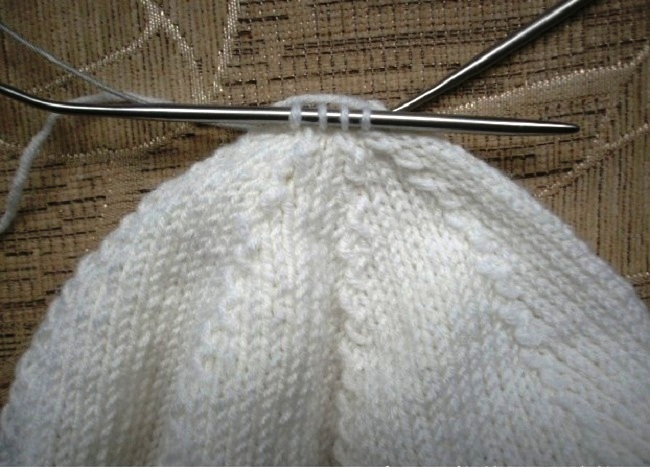 Knitting beret with knitting needles: a robot on the crown of beret.
Knitting beret with knitting needles: a robot on the crown of beret. - Collect the remaining loops onto the thread, tighten the thread and secure with the knot. If desired, decorate with a loop. For the loop: tie a string of 8 air loops, fasten them at the base and tie them with bunches without a crochet. Knitting beret with knitting needles: the end of work.
Simple female takes knitting needles with a description for beginners
Takes with openwork leaves: just knits - looks amazing. We proceed.
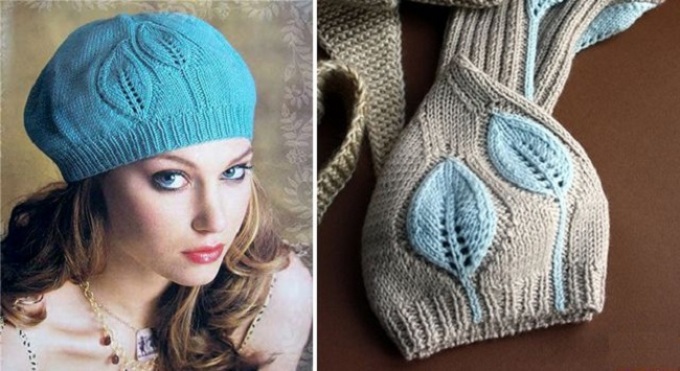 Berets for beginners
Berets for beginners Berth size( = head girth): 53.
For work you will need :
- Yarn, composition: 50% cotton, 50% bamboo. Weight - 100 grams, the yardage - 238 m. For work you will need a thread in one addition. Remarkably in this product will look a change of color for the leaves, however, and in the singleton looks smart.
- Tongs straight or circular # 3
Abbreviations used in description:
KP - Edge Hinge
PI - Back Loop
LL - Front Loop
LSP - Front Crossed Hinge( see photo above)
MP Marked Loop
2PVLP - 2 hinges together facing to the right( see the beginning of the article)
2(See the beginning of the article)
3 PVL - three loops along the front( see photo below)
RFP - loop added from the broach( tied with the front crossed)
N - nakid
OL - rotary row
KR - circular series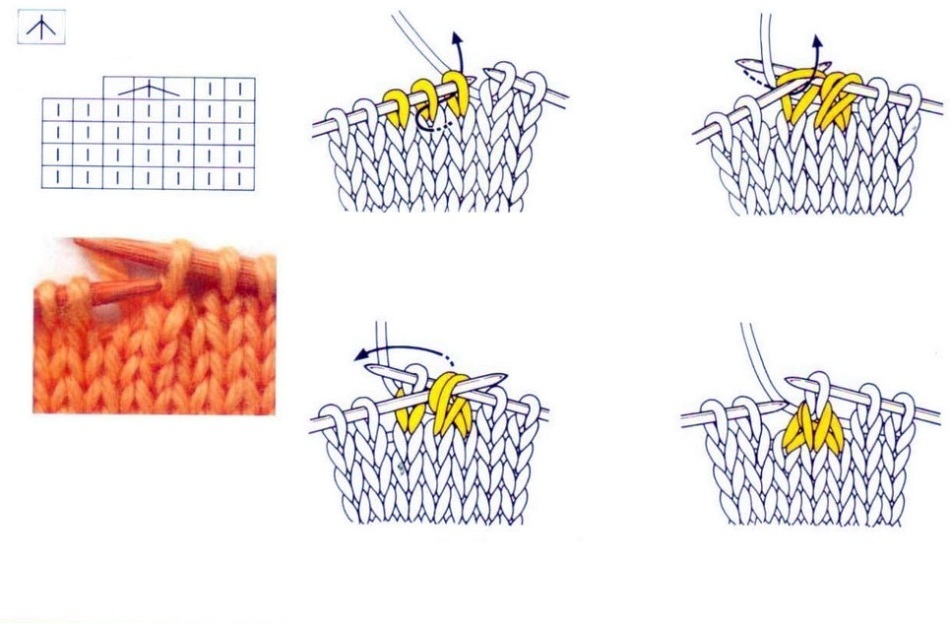 How to tie three loopsand together facial.
How to tie three loopsand together facial. "Leaf" pattern : according to the scheme.
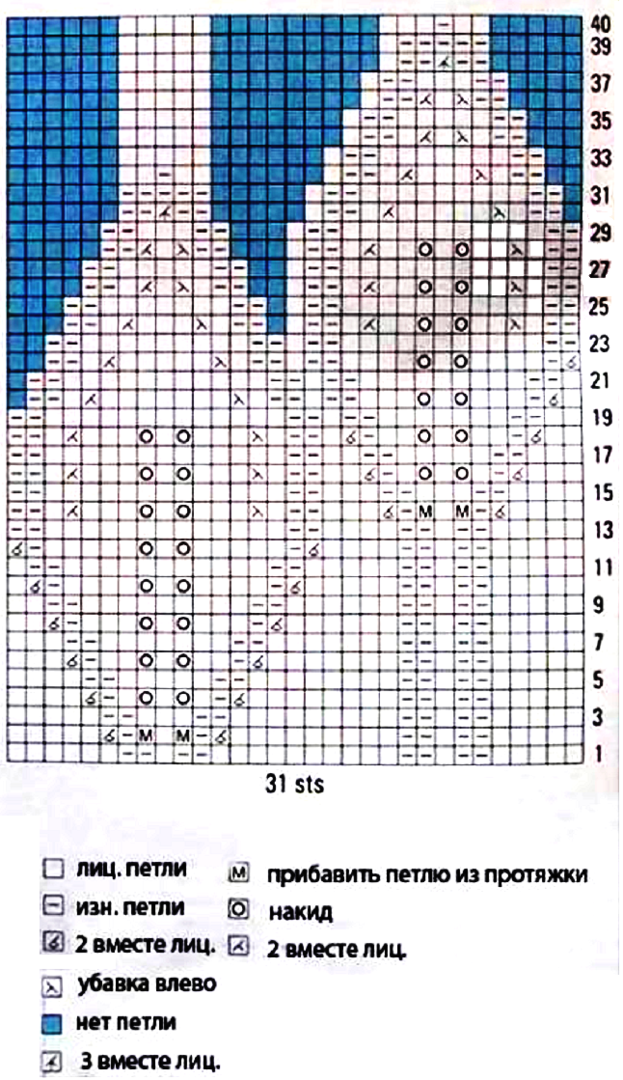 Scheme pattern "Leaf"
Scheme pattern "Leaf" Finishing : elastic band 2x2( 1x1).
Description of work:
- This model is knitted from the bottom up, i.e.work begin with a set of loops for a rubber band beret. On the spokes, dial 120 loops and close the set in a circle.
Important: Be sure to check the location of the tying loops before tying the first row. The loops must be inside the conditional circle. If necessary, eliminate the torsion of the row.
- Use an elastic band of 2x2( or 1x1) frontal hoop. The height of the detail is 3 cm.
- To form a free high-altitude part of the beret, do the following:
- mark with any convenient marker( for example, a colored thread) the 10th loop from the beginning and from the end of the CD;
- the first 10 loops of the KR are tying the LP( including the marked loop of the MP);
- then knit alternately: 2 LP, H and so to MP;
- the last 10 loops of the KR are tying LP( including MP);
- remove the markers.
After adding on knitting needles - 170 loops.
- Next CD knit LP, wrap around the LPS with nakids.
- To decouple the altitude of the beret:
- from the beginning of the CD, tie in 52 LPs( mark 52 with the marker)
- tie the 1st row according to the pattern of the "Leaf" pattern, mark the last loop of the pattern with the
- marker, knit the LP until the end of the CD.
- Continue to knit the high-rise part, focusing on the pattern and pattern of the canvas. The height of the motif with leaves is 40 kr. After finishing work on the motif on the spokes - 150 loops. Note: the blue color on the diagram is "no loop".The blue squares are not taken into account when reading the diagram. Such a technique is used to ensure that the symmetry in the graphic representation of the circuit is not violated.
- After finishing the work with the Leaf motif, remove the markers and, if necessary, knit all subsequent CDs of PL until the canvas height reaches 18 cm( from the beginning of the set edge).
- Proceed to the formation of the crown( bottom) of the beret. For this,
- 1st reduction: 1 st and 2 nd loop of KR, 2PVLP, 11 LP, 14th and 15th loop, 2 PSLLs. So you will form the first beret wedge. Continue to decrease until you form 10 wedges. At the end of the CD there are 130 loops on the spokes.
- 2nd KR decreases - only LP.
- 3rd KR reduction: 1 st and 2 nd wedge of the wedge tie 2PVLP, 9 LP, 12th and 13th loop, 2 PSLLs. Make a reduction for all wedges. At the end of the CD there are 110 loops on the spokes.
- 4 th reduction - only LP.
- 5th reduction: 1 st and 2 nd loop wedge 2PVLP, 7 LP, 10 th and 11 th loop wedge 2 PSLL.Make a reduction for all wedges. At the end of the CD there are 90 loops on the spokes.
- The 6th reduction is only LP.
- 7th reduction: 1 st and 2 nd loop wedge 2PVLP, 5 LP, the 8th and 9th loop of the wedge, 2 PSLL.Make a reduction for all wedges. At the end of the CD there are 70 loops on the spokes.
- The 8th reduction is only LP.
- 9th reduction: 1 st and 2 nd loop wedge 2PVLP, 3 LP, 6th and 7th loop of the wedge, 2 PSLL.Make a reduction for all wedges. At the end of the CD there are 50 loops on the spokes.
- The 10th reduction is only LP.
- 11th reduction: 1 st and 2 nd loop wedge 2PVLP, 1 LP, 4 th and 5 th loop wedge 2 PSLL.Make a reduction for all wedges. At the end of the CD there are 30 loops on the spokes.
- 12th KR after decrements - only LP.
- 13th KR reduction: alternately knit 1 LP, 2PVLL and so on until the end of the CD.At the end of the CD there are 20 loops on the spokes.
- The 14th reduction is only LP.
- 15th reduction: cut alternately 1 LP, 2PVLL and so on until the end of the CD.At the end of the CD there are 10 loops on the spokes.
- The 16th reduction is only LP.
- 17th reduction: cut alternately 1 LP, 2PVLL and so on until the end of the CD.At the end of the CD there are 5 loops on the spokes.
- Cut the work thread, put the remaining hinges on it, tighten and fasten it.
Baby takes with knitting needles for beginners
Berets are very popular with charming princesses of all ages. However, the young brave ones are very fit to face.
The following diagrams are simple to perform and do not limit the imagination in choosing a color solution or decor.
Takes with pompon
 Child takes knitting needles.
Child takes knitting needles. Berth size( = child's age): 2/4( 6/8) 10/12 years.
The width of the beret over the head girth: 41( 46) 51 cm.
For work you will need :
- Yarn, composition: 100% wool. Weight - 100 grams, the meterage - 23 m. For work you will need a thread in one addition.
- Spindles straight or circular # 3, # 3,5
Abbreviations used in description:
PR - swivel series
LP - face loop
IP - reverse loop
H - nakid
ISP - reverse crossed loop( see photo below)
2PVLP - 2 loops along the front with a slope to the right( see the beginning of the article)
2 PVLL - 2 loops along the front with a slant to the left( see the beginning of the article)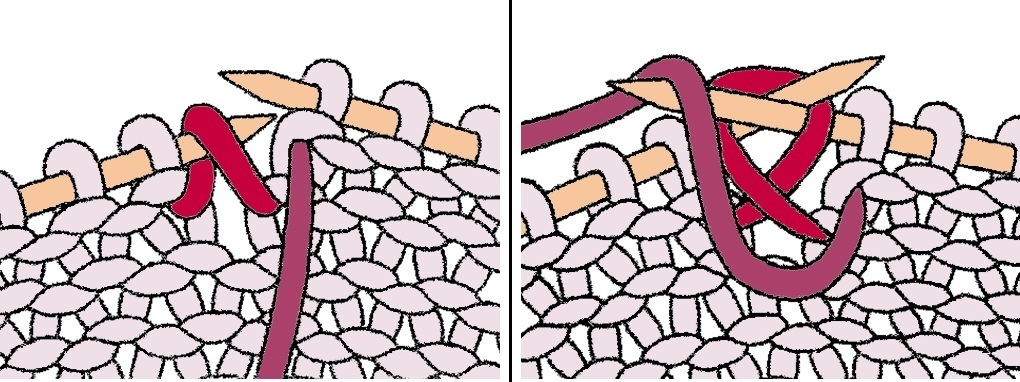 How to tie a crochet with the wrong crossed loop
How to tie a crochet with the wrong crossed loop Basic pattern :
- garter. All PRs are knit LPs.
- facial mating. Face series - LP, purl rows - IP.
Job description:
Be careful: the description is for three age categories 2/4( 6/8) 10/12 years!
You can associate a plain beret or its striped variant - it all depends on your personal preferences.
- Takes a knit from the bottom up, i.e.work with a set of loops for the rim of the beret. On the spokes, dial 98( 110) 122 loops. Tie a garter-stitch bezel with a height of 2( 3) 4 cm. Work OL.
- Go to the spokes # 3,5.Work continue face viscous( rows rotary).Perform the increments to form the beret's crown:
- 1st increment: 8( 9) 10 LP, * N, 2 LP, H, 14( 16) 18 LP.Repeat from * to *.Complete the PR: H, 8( 9) 10 LP.After adding 110( 122) 134 loops to the spoke.
- 2nd RD increment: IP.If you do not like openwork holes in the place of nakidov, tie the capes of the ISP.
- of the 3rd RP increase: 9( 10) 11 LP, * H, 2 LP, H, 16( 18) 20 LP *.Repeat from * to *.Complete the PR: H, 9( 10) 11 LP.After adding on the spoke - 122( 134) 146 loops.
- 4th and all subsequent even OL increments knit as 2nd PR.
- In total, perform 7( 9) 11 OL increments by adding loops on both sides of the tracks from 2 LPs.
- After the last PR of the increments, tie 3 PR without adding, focusing on the pattern of knitting.
- To form the crown( bottom) of the beret, continue the work of the PR with decrements:
- 1st reduction: before the track of 2 LPs, 2 PSLLs are to be fastened, and after the path from 2 LPs - 2 PVLPs.
- 2 nd, 3 rd, 4 th RR: no reduction;knit, focusing on the pattern of the canvas( the wrong side is the IP, the front side is the LP).
- 5-th PR reduction: knit the same as the 1st PR.
- 6th, 7th, 8th PR: no reduction.
- Loosen loops in each 4th PR( see description above) until 15( 16) 17 loops are left on the spoke.
- Cut the work thread, stretch it through the remaining loops, fix the thread.
- Sew a beret. If desired, make a decorative loop or sew a pompon.
Warm beret with braids
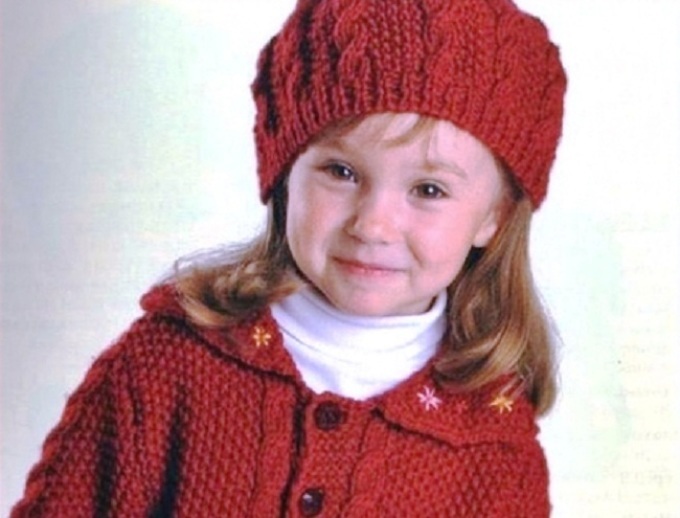 Warm beret with braids
Warm beret with braids 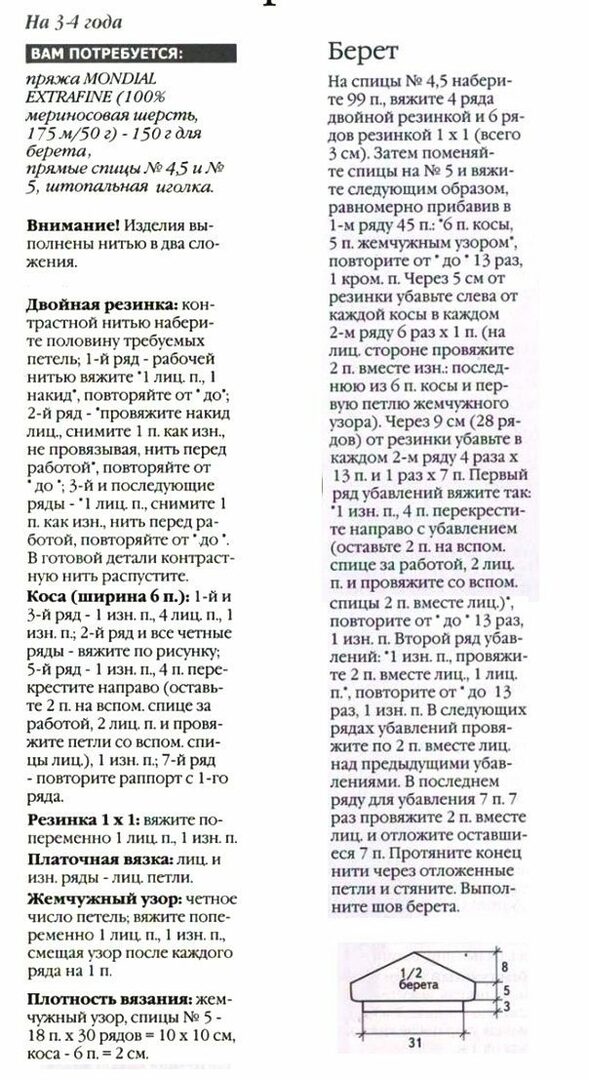 Description of the stages of knitting a warm beret with braids.
Description of the stages of knitting a warm beret with braids. Takes with an openwork pattern for the smallest
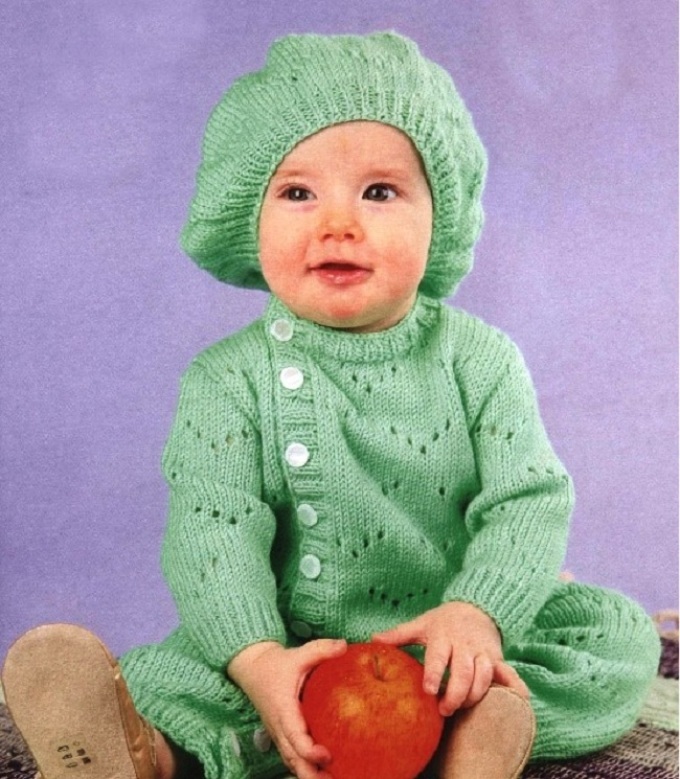 Takes with an openwork pattern for the smallest
Takes with an openwork pattern for the smallest 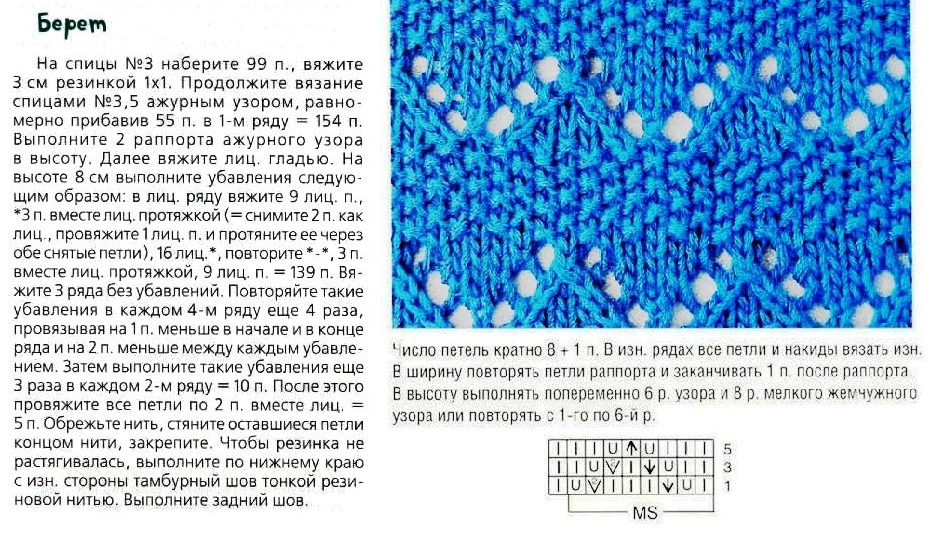 Description of the steps knitting beret with an openwork pattern for the smallest
Description of the steps knitting beret with an openwork pattern for the smallest Patterns for berets with knitting needles: sketches and description
Berets are always in fashion. Only accessories are changed: scarves give way to snows, and gloves to mittens.
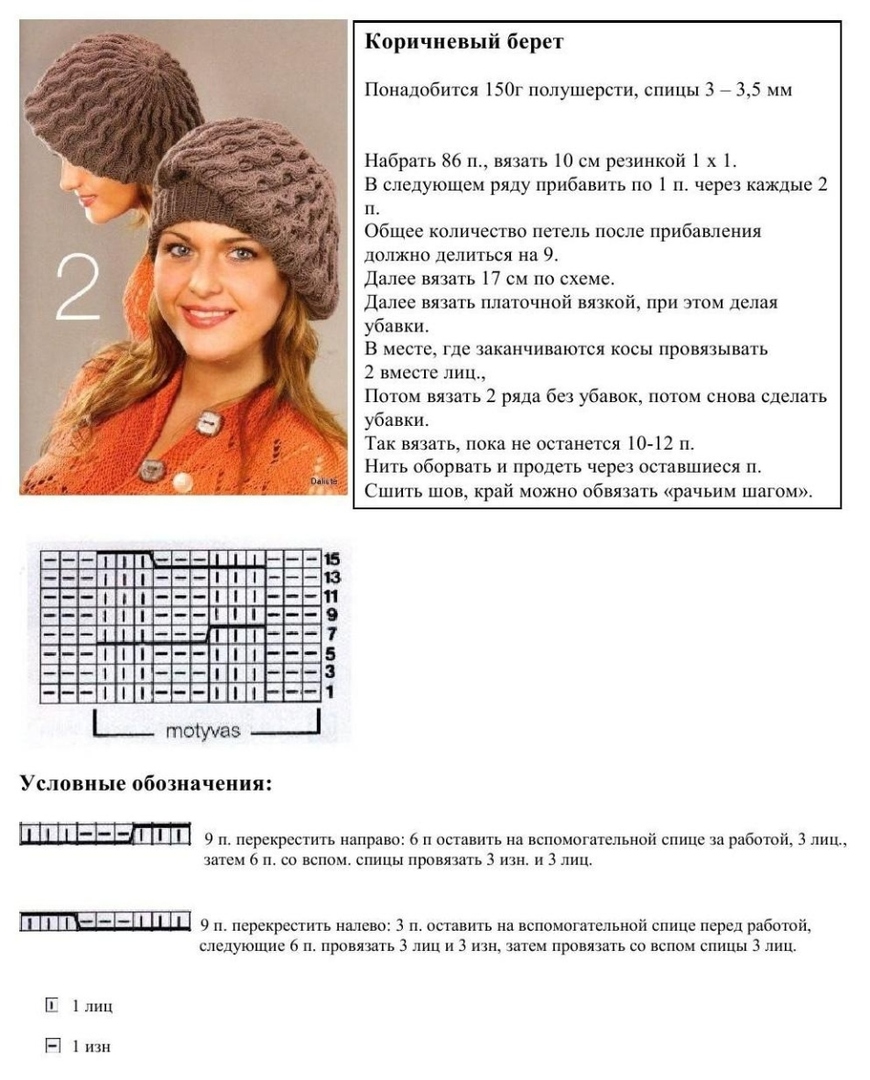 Patterns for berets with knitting needles: schemes and descriptions # 1.
Patterns for berets with knitting needles: schemes and descriptions # 1.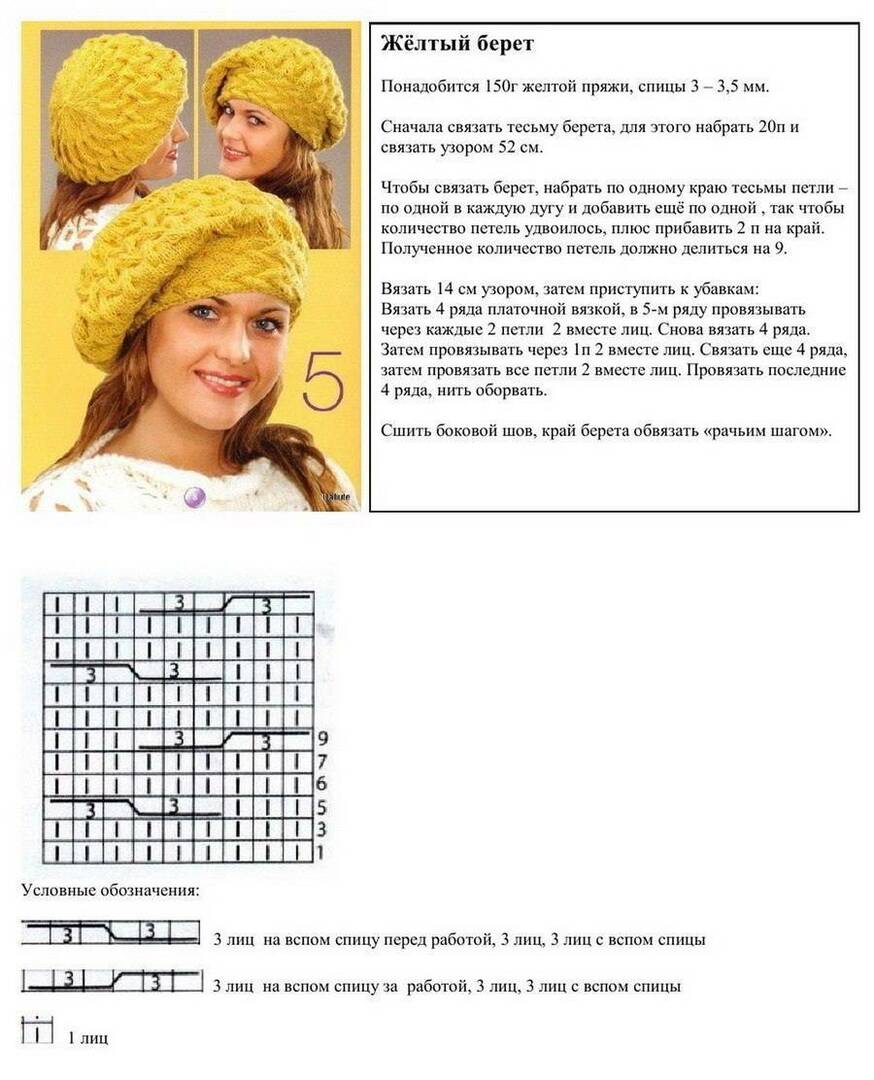 Patterns for berets with knitting needles: schemes and descriptions # 2.
Patterns for berets with knitting needles: schemes and descriptions # 2.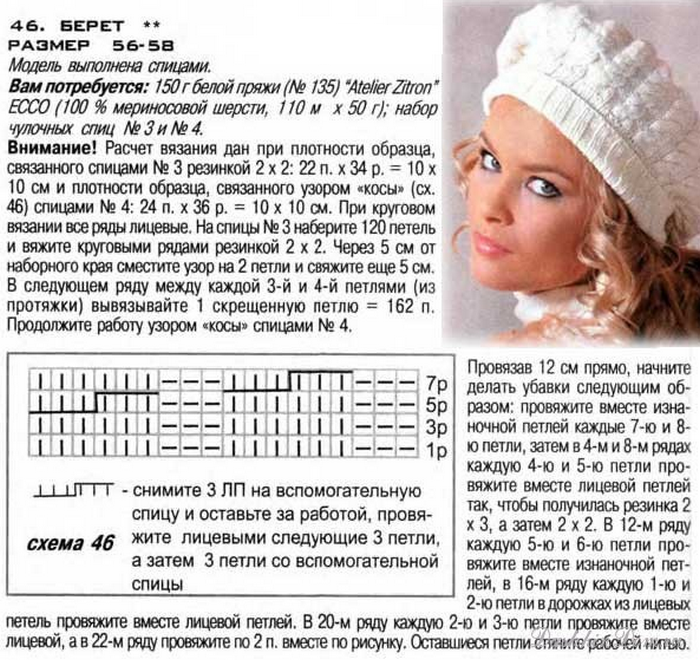 Patterns for berets with knitting needles: schemes and descriptions # 3.
Patterns for berets with knitting needles: schemes and descriptions # 3.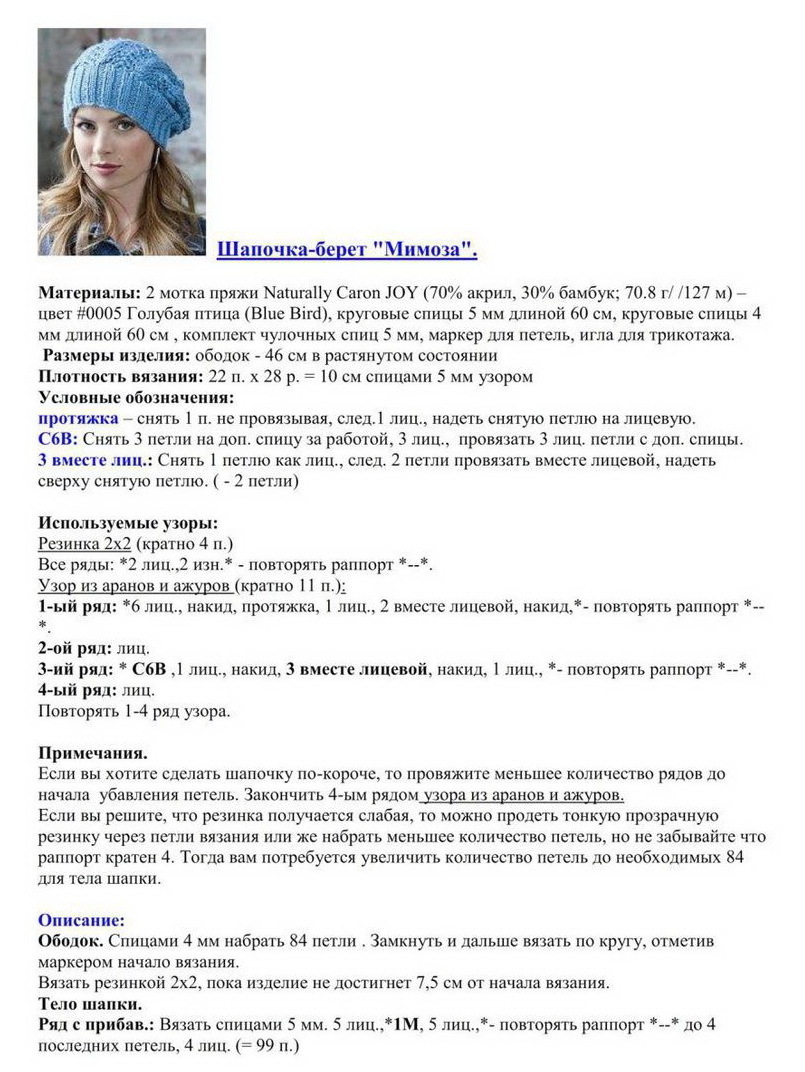 Patterns for berets with knitting needles: schemes and descriptions # 4.
Patterns for berets with knitting needles: schemes and descriptions # 4.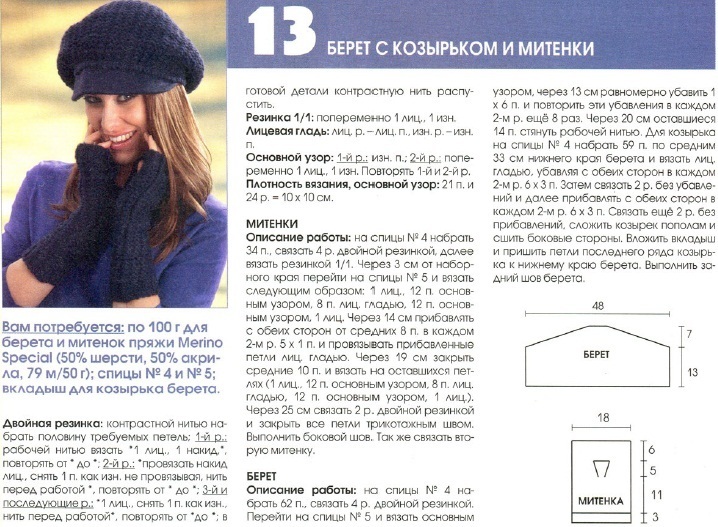 Patterns for berets with knitting needles: schemes and descriptions # 5.
Patterns for berets with knitting needles: schemes and descriptions # 5.The size of the bottom of the beret crocheted: how not to make a mistake in the amount?
- Measure the head circumference( OG).
- Determine the diameter of the bottom: OG / 2.
Make sure that the bottom of the beret remains flat.
 Practical lights for knitting a flat circle crochet.
Practical lights for knitting a flat circle crochet. Video: Hook for beginners - knitting circle
Crochet elastic band: description
The crocheted elastic band is not inferior to the rubber band, knitted. Carefully watch the video "RUBBER HOOK.Knitting Patterns, which clearly explains all the stages of knitting.
Video: RUBBER CROWN.Knitting Patterns
Crochet Crochet for Beginners: A detailed description of the
Cropped crochet can be tied using in the work only posts without a crochet.
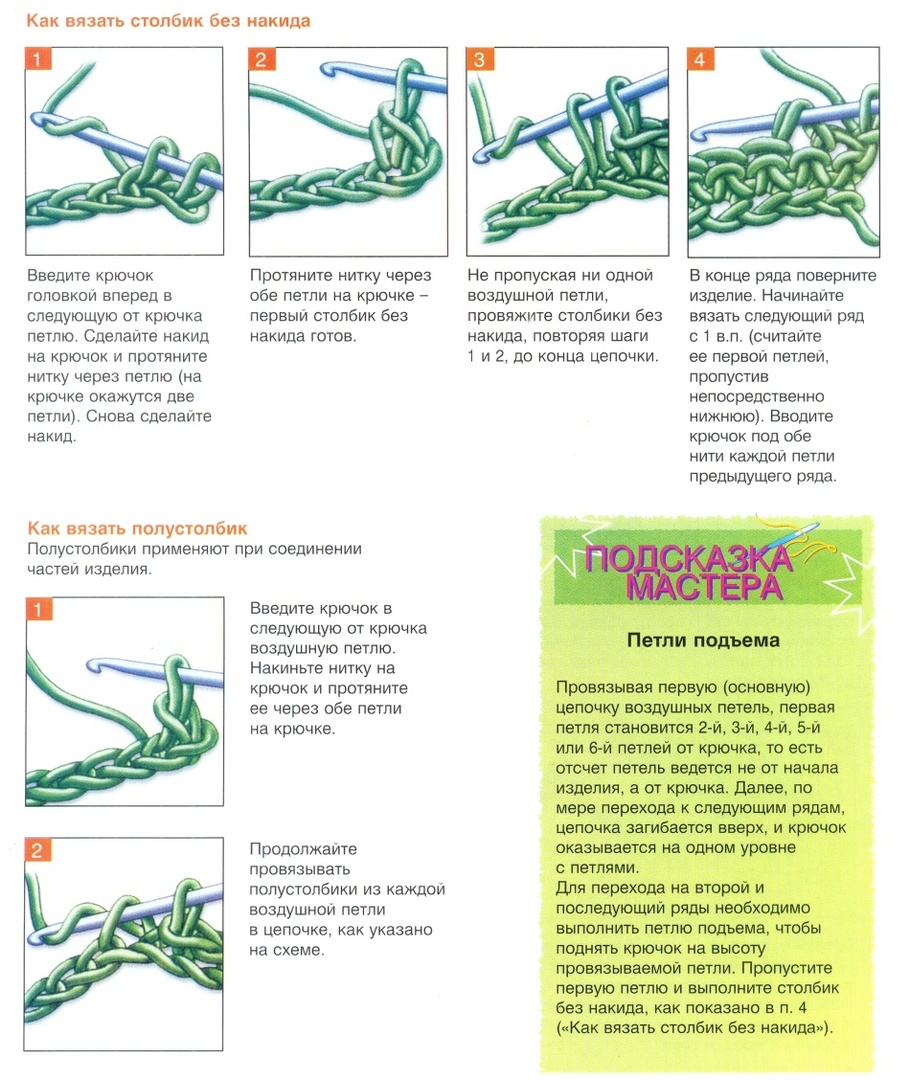 How to knit stitches without crochet.
How to knit stitches without crochet. Video "Beret Classic Crochet" offers a detailed MC for knitting a stylish headdress.
Video: Beret Classic crochet
Summer crochet: sketch and description for beginners
 Summer crochet: a scheme and description for beginners # 1.
Summer crochet: a scheme and description for beginners # 1.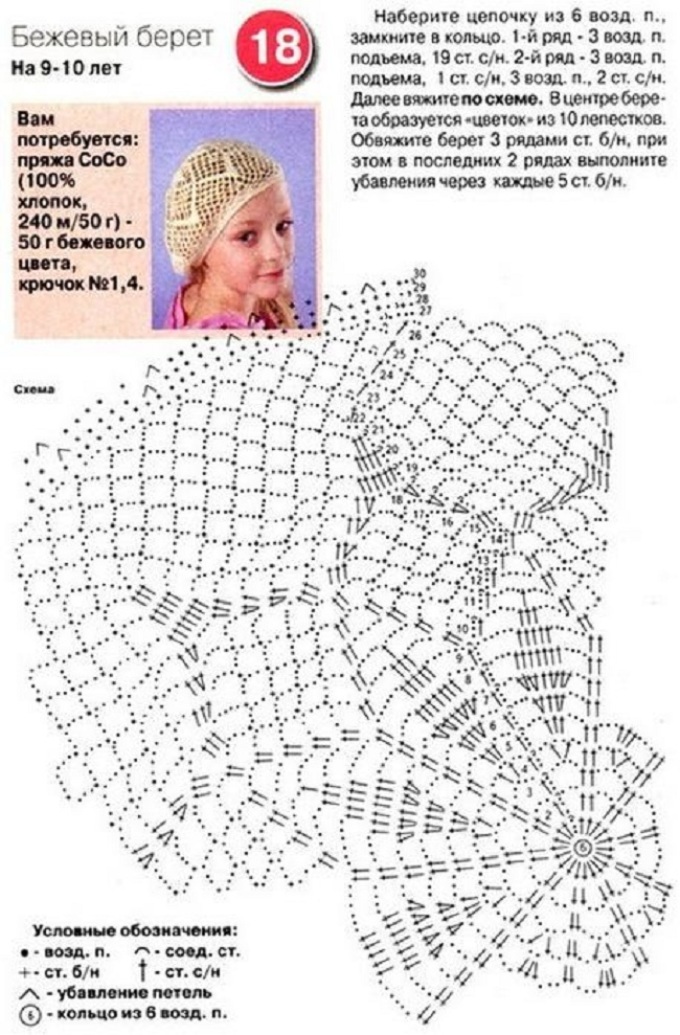 Summer crochet: a scheme and description for beginners # 2.
Summer crochet: a scheme and description for beginners # 2.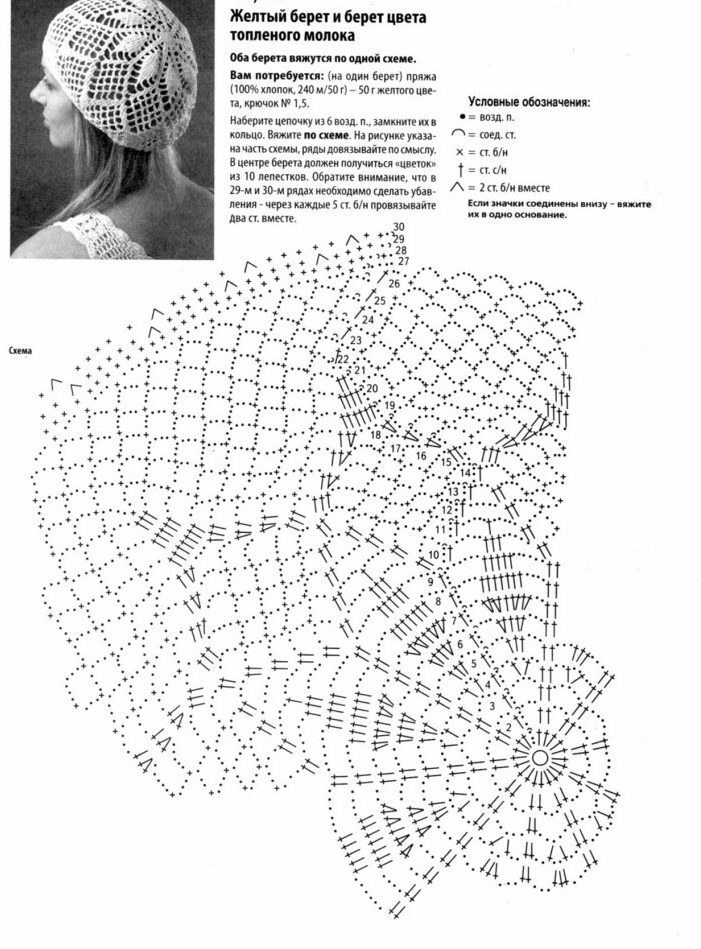 Summer crochet: a scheme and description for beginners # 3.
Summer crochet: a scheme and description for beginners # 3.Baby Berets for Beginners
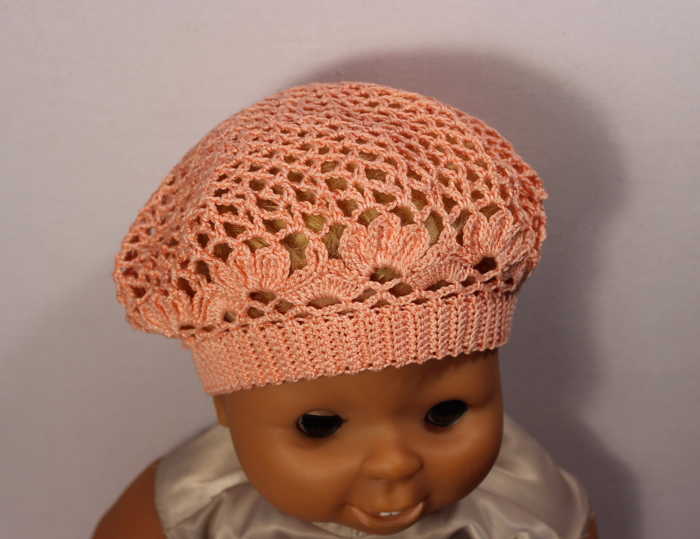 Baby Berets by Victoria Isakina
Baby Berets by Victoria Isakina Experienced craftsmen advise knitting the bottom of the beret on any round scheme you like. As soon as the bottom of the beret reaches the required diameter, tie a few centimeters of columns with a crochet, make a uniform decrease and finish with an elastic band.
Video "How to tie a children's summer crochet. How to crochet beret free pattern tutorial #crochet_beret »offers a detailed MC for knitting a baby beret from the masteress Victoria Isakina.
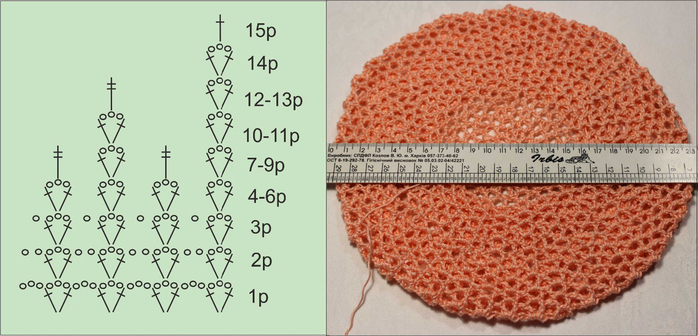 Scheme for baby beret crocheted by Victoria Isakina.
Scheme for baby beret crocheted by Victoria Isakina. Video: How to tie a children's summer crochet. How to crochet beret free pattern tutorial #crochet_beret
Crochet pattern for beret: sketch and description
Simple yet stylish and yet very stylish beret.
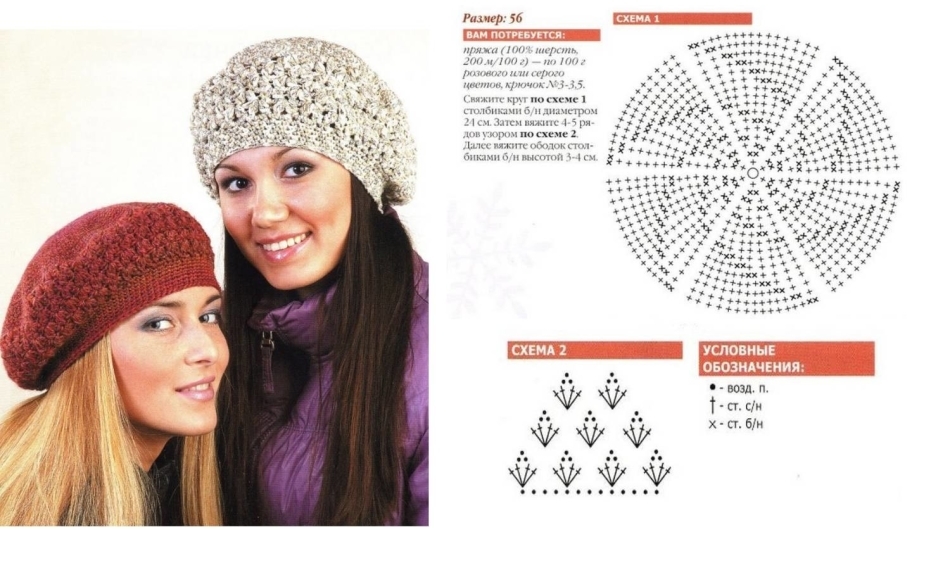 Crochet Crochet Pattern: Diagram and Description
Crochet Crochet Pattern: Diagram and Description How to Tie a Crochet for Beginners: Video
Video MC is a great opportunity for inexperienced craftsmen to learn new techniques and create beautiful things with their own hands.
Video: Summer crochet for beginners 1 part Crochet
Video: Summer crochet for beginners Part 2 How to crochet beret?
